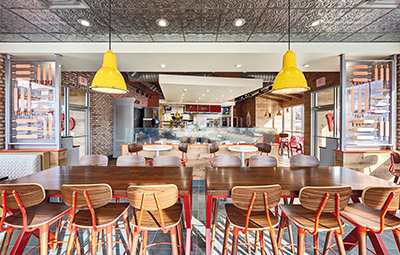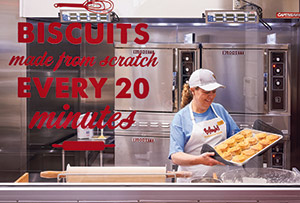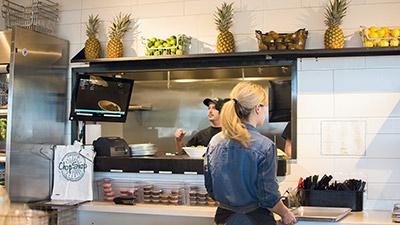To offer some insights on the direction of prototype designs, FE&S tapped four experts from the most prolific design and branding firms, who collectively have created new prototypes for some of world’s biggest brands and hottest startups
- Kathy Fiorenza, account director of food concepts at Chute Gerdeman Inc.
- Tre Musco, founder and CEO of Tesser
- Lynn Rosenbaum,vice president, retail environments at Chute Gerdeman Inc.
- Steve Starr, founder and president of starrdesign
FE&S: Consumer expectations are changing. What's the big-picture impact on prototype trends?
Starr: Within even just the past 24 months the baseline in terms of what consumers expect has risen significantly. Stuff that used to be  Located inside Stripes Convenience Stores, Laredo Taco Company’s new prototype features optional self-service kiosk ordering and fresh tortilla making at the start of the order assembly line. Photo courtesy of Stripes Convenience Storesunique and memorable, that used to be a differentiating feature, is now pretty much expected. It's no longer enough to be "fresh food fast" or to source responsibly or to have an industrial-chic aesthetic and use reclaimed barn wood.
Located inside Stripes Convenience Stores, Laredo Taco Company’s new prototype features optional self-service kiosk ordering and fresh tortilla making at the start of the order assembly line. Photo courtesy of Stripes Convenience Storesunique and memorable, that used to be a differentiating feature, is now pretty much expected. It's no longer enough to be "fresh food fast" or to source responsibly or to have an industrial-chic aesthetic and use reclaimed barn wood.
We're at a point where operators really need to refine their game and clearly express in their branding what differentiates them if they want to resonate with consumers. And expectations for speed and quality just keep rising. Customers today expect, and are getting, great food from a drive-thru or express pickup. Five years ago, that's an oxymoron.
Musco: Consumers are making less of a distinction between QSR and fast casual. Our research shows that it's all just fast food to them, but there's a big distinction between old-school fast food and next-gen fast food. Certain design cues say old-world QSR. It might be boxes that all look exactly alike or uncomfortable, brightly lit spaces with hard plastic seats. Big, back-lit menu boards can now flag old-school fast food, as do heat lamps and closed-off kitchens.
These aren't bad things from a business-model standpoint — fast, efficient and cheap — but from a prototype design standpoint they now have negative connotations, especially to younger consumers. Even on big-brand projects we're constantly trying to challenge and say, "Okay, what can we do that is different than what people expect from you?"
Fiorenza: Expectations for fast and convenient continue to accelerate. Fast today is a lot faster than it was even a year ago. That's why we think technology has such an important role in enabling restaurants to capture market share, because consumer demands in these areas aren't going to let up. Companies we work with are acutely aware that how they utilize technology in the design of their restaurants going forward is going to be critical.
At the same time, there's still the expectation that the human touch needs to be there in all the right places. Striking a balance between having labor where needed to get the most credit from customers and employing technology to meet expectations for speed and convenience is a big challenge right now.
Rosenbaum: And along with speed and convenience are growing expectations for experience, authenticity and transparency. You can be fast and convenient, as the old-school QSRs have been for years, but the big change is toward creating environments that speak strongly to these three things.
FE&S: How can design help convey the critical concepts of experience, authenticity and transparency?
 The new Bojangles’ prototype changes the traditional QSR experience with a modern appearance and branding that focuses on authenticity, transparency and from-scratch cooking. Photo courtesy of Bojangles’Rosenbaum: Providing transparency and exposure from the back of the house into the dining room is a big one. With most brands, there's a certain amount of back-of-the-house operations you don't want customers to see, but if there are parts of the process that can be exposed and highlighted, something that supports your brand promise, people love to see that.
The new Bojangles’ prototype changes the traditional QSR experience with a modern appearance and branding that focuses on authenticity, transparency and from-scratch cooking. Photo courtesy of Bojangles’Rosenbaum: Providing transparency and exposure from the back of the house into the dining room is a big one. With most brands, there's a certain amount of back-of-the-house operations you don't want customers to see, but if there are parts of the process that can be exposed and highlighted, something that supports your brand promise, people love to see that.
For Wingstop, for example, we created a design that gives visibility into one part of the process, the hand-breading and seasoning of the fresh wings. We've also worked with Laredo Taco Company, which operates in Stripes convenience stores. It's a taco shop in a c-store, but they've included a station on the front line where an employee is making fresh tortillas. The dish station and storage remain in back, but hero things that can be exposed are being exposed.
Fiorenza: Right. It's about getting credit for fresh, hand-made, cooked-to-order — the things you want to get credit for. And from an experience standpoint, it's theater. There will always be brick-and-mortar restaurants because people want some level of engagement, they want to be entertained and feel like they're getting an experience.
Starr: For many brands, it's a balance — creating the food theater on the item or process that you really want to highlight and then almost automating everything else to reduce labor and increase efficiency. We just completed a prototype design for Original ChopShop in the Phoenix/Scottsdale market. Its tagline is "Just Feel Good Food," and it was built around healthful food for busy people. To underscore the fresh and healthful slant, we broke the kitchen into the cold side, which includes fresh juices, acai and pitaya bowls, protein shakes and specialty beverages, and the hot side, which is entree salads, protein bowls, sandwiches, etcetera.
automating everything else to reduce labor and increase efficiency. We just completed a prototype design for Original ChopShop in the Phoenix/Scottsdale market. Its tagline is "Just Feel Good Food," and it was built around healthful food for busy people. To underscore the fresh and healthful slant, we broke the kitchen into the cold side, which includes fresh juices, acai and pitaya bowls, protein shakes and specialty beverages, and the hot side, which is entree salads, protein bowls, sandwiches, etcetera.
The prototype design spotlights the cold side. Behind the front registers there's a beautiful white marble-looking island where the juices are pressed. There's fresh fruit everywhere, cold bowls are assembled, shakes are made and specialty teas are displayed. Right behind the cold side expediter area is the pass-through window to the hot side, where we introduced some new cooking technologies to improve quality and efficiency. There's transparency into the hot side, but it's not the center of the show.
Musco: Obviously, the big chains that often get accused of not providing the type of experiences and authenticity and transparency that next-gen customers want are still doing OK. McDonald's and Subway alone feed a huge portion of the population every day. But if you ask consumers whether they like them, or which chains are aspirational to them, you tend to get responses around newer chains that have more authenticity, more localization. Larger chains are working to bridge that gap.
We helped create a new prototype design for Bojangles', which is a great example. They have a very authentic story, their food is great and they've made a big investment in the guest experience by opening up kitchens, creating biscuit theaters that showcase their signature biscuits being made, refining their graphics, creating comfortable, modern environments and really focusing on fresh food quality. It could be considered a typical fast-food concept, but the new prototype counters a lot of the perceptions around the typical fast-food experience.
FE&S: Mobile orders, takeout and delivery are growing fast. How do — or should — new prototype designs accommodate that?
Rosenbaum: Brands have to think very carefully about how to satisfy two broad customer bases: those who have ordered before getting to the store and those who haven't. Looking at the QSR segment, nobody has really figured out how to treat what we call the "app customer" differently from the customer placing an order on-site. They still have to get in the same drive-thru line as everyone else. How is that efficient? You want to transition drive-thru customers to app customers because of all the data and marketing benefits, but are we really giving people a reason to order remotely by virtue of the experience they get at the store? Not yet, at least at the drive-thru.
For app customers who are walking into the store, the scenario makes more sense. Operators are incorporating express pickup locations inside to let them bypass other lines so there's a clear advantage to ordering ahead, especially in fast-casual restaurants where the wait times can be longer.
Musco: Part of it is designing stores in such a way that people can still queue up in the traditional line, but someone else can walk right by and pick up their food, which they've ordered remotely, without traditional customers feeling slighted or fights breaking out. Another implication of takeout growing faster than dine-in is that operators will need less front-of-the-house space and footprints can be smaller.
 The kitchen at Original ChopShop includes separate cold and hot sides. Right behind the cold side expediter area is the pass-through window to the hot side.There's a lot of right-sizing going on already as takeout and delivery grows and everyone wants these capabilities baked into their new facilities. That's true even if their IT platforms aren't yet ready. We're doing spaces that are prewired for self-ordering and have room to add app-based order pickup areas when the time comes.
The kitchen at Original ChopShop includes separate cold and hot sides. Right behind the cold side expediter area is the pass-through window to the hot side.There's a lot of right-sizing going on already as takeout and delivery grows and everyone wants these capabilities baked into their new facilities. That's true even if their IT platforms aren't yet ready. We're doing spaces that are prewired for self-ordering and have room to add app-based order pickup areas when the time comes.
Fiorenza: The big thing is making sure each type of customer, whether they're grabbing-and-going or ordering and dining in, has a clearly marked path. There also needs to be flexibility. An app customer may decide on the spot to eat in, hang out for a while and get some work done. The design should allow for a seamless, inviting experience no matter how customers choose to use the restaurant.
Rosenbaum: Even while takeout is growing, we're transitioning into the dining room being more of a place where, if you're not taking out, we're inviting you to stay and hang out as long as you want. It's kind of the Starbuck's third-place scenario, and it's about giving customers lots of choices for how they want to dine in. Outside on the heated patio? By the TV to watch the game? At a high-top communal table with a group? There's a big focus on providing a variety of options and experiences.
Starr: At Original ChopShop, 40 percent to 45 percent of sales are from takeout. We designed a separate register and staging area for those orders as well as a waiting area so you don't feel like you're sitting on a stool in the corner or standing around in everyone's way. We paid a lot of attention in the design so that doesn't happen. Instead, you're in a raised area where you can watch the food theater — juices being pressed, shakes being made, fresh fruits being prepped, etcetera. Just because it's takeout doesn't mean you can skimp on the experience.
And you have to have the right equipment to ensure quality is maintained. Consumer expectations for quality are only going up, so how do you maintain that first-bite temperature, optimum flavor and texture when an order may have to be staged for a while? If you're going to play in that space, the right equipment is essential.




